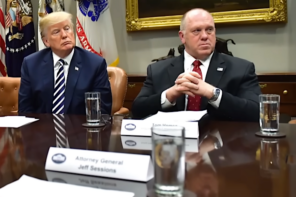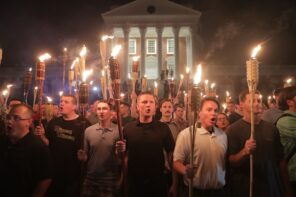As one might imagine, Yale University’s recent conference on White Christian nationalism and the midterm elections was full of sobering information. And yet, two conclusions managed to stand apart from the rest. First, that the phenomenon is firmly anchored within the Republican and conservative mainstream; and second, that its most fanatical proponents keep moving further and further to the Right.
This was illustrated most urgently by Bradley Onishi, RD contributor and author of the upcoming book Preparing for War: The Extremist History of White Christian Nationalism – And What Comes Next, who spoke about White Christian nationalists who’ve taken to their own enclaves to realize their dreams of an American theocracy. Led by former military officer James Wesley Rawles, Onishi explains, Christians have been flocking to the region of Idaho, Montana, Wyoming, and parts of Eastern Washington and Eastern Oregon, which Rawles has named “the American Redoubt.” The goal, as Onishi notes, is an insidious one:
“For Rawles and Baldwin, the goal is to create a separate society of American Christians who will defend their families and communities when the next civil war dawns.”
It would be wrong however, to believe that the American Redoubt movement and their dreams of theocracy are condemned to the fringes of American religious life:
“(…) His popularity speaks to the resonance his worldview has with millions of Americans—and the influence it is having on the Redoubt region. Rawles claims his website, survivalblog.com, has 320,000 unique visitors per week. He is a New York Times–bestselling author. He has five novels and two nonfiction books published by major houses—Simon & Schuster and Penguin Random House.”
Onishi also warns against the belief that Rawles is only popular with survivalists, pointing to his connections to former elected officials like Matt Shea, who made headlines with his manifesto for “Holy War.” Though Shea no longer holds office, according to Onishi this is no time for complacency:
“[Shea] had become too extreme for one of the most radically conservative parts of the country. But he found a safe landing spot: the church. Shea is now the pastor of On Fire Christian Ministries and Kingdom Christian Academy in Spokane, Washington, where he regularly preaches the Gospel of the Redoubt.”
While dreams of American Theocracy are being fostered in the American Northwest, sociology professor Cynthia Miller-Idriss’s presentation focuses on how the far-right White nationalist fringe is responding to the themes and narratives of White Christian nationalism. The common denominator, which makes proponents of White Christian nationalism more susceptible and potentially open to moving even further Right, according to Miller-Idriss, are themes of purity of body and the nation:
“Hierarchies of superiority and inferiority, that are justified as the ‘natural order of things’ or ‘god-given’ or ‘god-ordained’ order of society. It’s hard to emphasize enough how absolutely foundational hierarchies of inferiority and superiority are to all supremacist world-views.”
Miller-Idriss ties the central White Christian nationalist view—that of a god-given, racialized order of nature and society led by White cis men, which is under threat—to far-right forms of White nationalism, pointing out that among those who have embraced the far-right, she’s frequently observed a moment that feels to them “like the pieces of the puzzle fitting together.” A feeling that the pre-existing structure of their world view, which is shaped by a more mainstream White Christian nationalism, neatly fits into a larger picture, when they’re exposed to far-right material.
This, she explains, is often referred to as red-pilling in far-right spaces, but is also compared to a spiritual experience: “like being baptized or reborn, an awakening.” The prevalence of the far-right “Great Replacement” conspiracy theory among the conservative mainstream is extremely concerning—its arguments are deeply rooted in antisemitism, ideas of territory and the racialized geography of ecofascism.

Image: @JeffSharlet/Twitter
Whereas Miller-Idriss draws an ideological map of the interconnections of White Christian nationalism and White nationalist ideology, reporter and author Jeff Sharlet has spent the last couple of months traveling the United States for his upcoming book The Undertow: Scenes from a Slow Civil War, to meet and talk with those who not only espouse these views, but who also proudly proclaim and announce them by displaying fascist symbols.
Sharlet offers chilling insight into their accelerationist worldview, sharing a cornucopia of photos that illustrate the openly authoritarian and fascist streak on the Right. Prominent among these is the black flag of “no quarter given,” which proclaims that no mercy will be granted to those considered the enemy—whether they be BIPOC, LGBTQ, left-leaning, antifascists, you name it.

Image: @JeffSharlet/Twitter
“It is a murder flag, a genocide flag,” Sharlet explains. It’s just one of a plethora of fascist symbols that he’s encountered all over the US, including the now-ubiquitous thin-blue-line flags, skulls, and guns. He sums them up as “the new authoritarians’ memento mori—the credo that we all must die, but some must die first.”
His warning is chilling: While fascist symbols and imagery, and fascist marches like those by the Patriot Front, are often dismissed as silly cosplay, they are anything but silly. He describes it as a metaphor that comes to life—and delivers a somber warning from the instances in the field, where he himself has had guns pointed at him. “When one person has a gun, it is never cosplay. The threat is always real,” he says.
As White Christian nationalism is omnipresent on the Republican campaign trail, so are promises of political violence. Sociologist Eric McDaniel doesn’t, therefore, view White Christian nationalism—which he refers to as Religious American Exceptionalism—as a tool whose primary purpose is to persuade the undecided to vote Republican. Rather, he views it as a tool to rile up the base and, potentially, to suppress opposition turnout through intimidation—both at the polls and in the lead-up to the vote.
Fellow sociologist Samuel Perry‘s findings fit neatly into the bigger picture of an ideology that has arrived in the mainstream but continues its rightward march. His latest research shows that while Democrats operate within a coalition that keeps expanding, Republicans strive further towards racial and ideological “purity”—fully becoming the party of White conservative Christians.
Full disclosure: the author attended the conference as a speaker.





